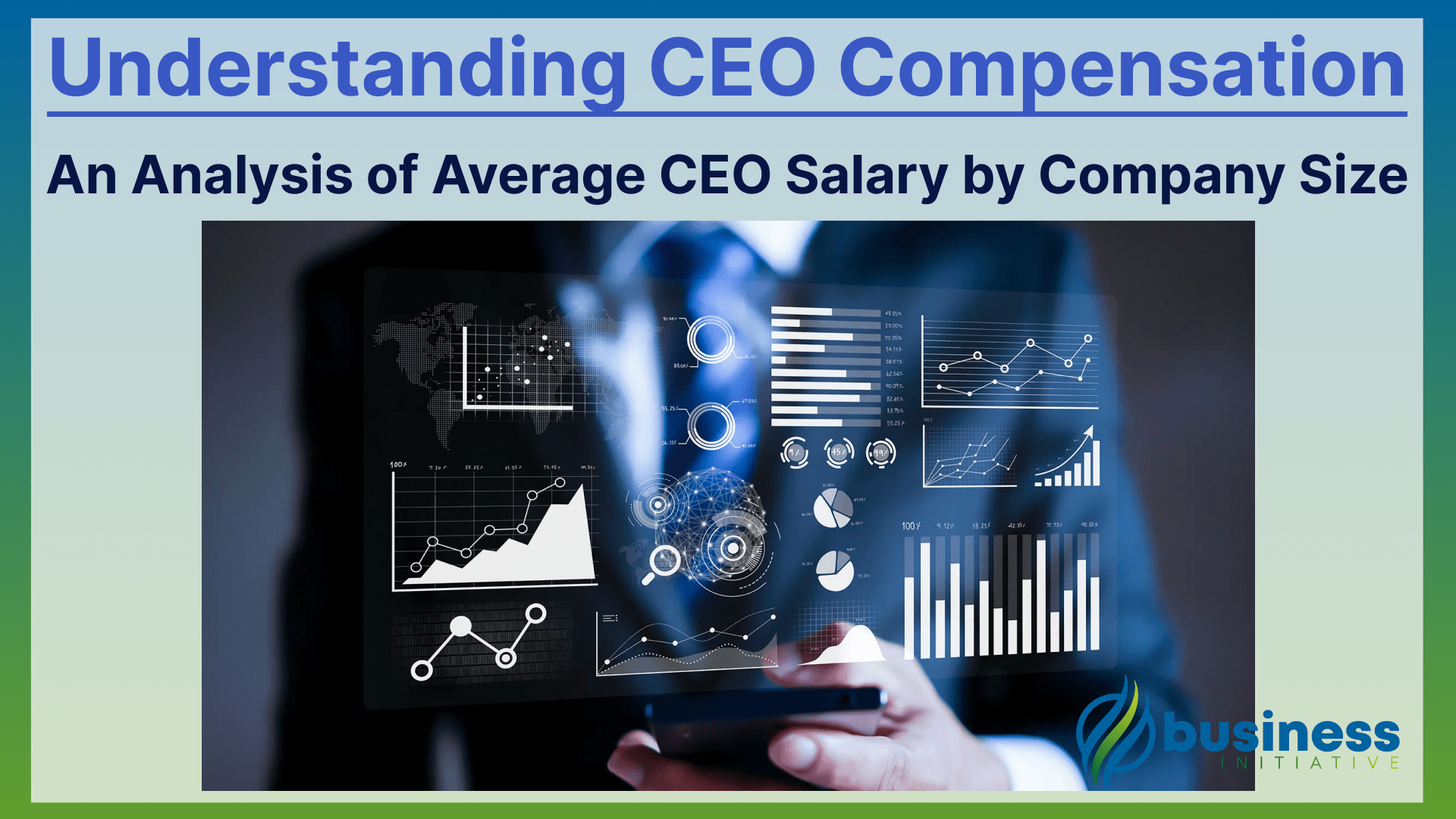In the ever-evolving landscape of corporate governance, the topic of CEO compensation remains at the forefront of discussion.
This article delves into the intricacies of CEO salaries, exploring the factors that influence executive pay, the trends shaping these compensation packages, and the implications they have for various stakeholders.
 Key Takeaways
Key Takeaways
- The size of your company significantly influences the salary range and structure of CEO compensation, with larger companies typically offering higher pay and more complex packages.
- Aligning CEO pay with company performance through bonuses and stock options can motivate top executives to drive business success and align their interests with shareholders.
- Stay informed about regulations affecting executive compensation, such as the Dodd-Frank Act, to ensure compliance and adapt your compensation strategies accordingly.
- How your company approaches CEO pay can affect its public image and employee morale, making transparency and fairness in compensation practices essential.
- Offering equity as part of the compensation package can be an effective way to attract and retain top talent while aligning their interests with the long-term success of your business.
Understanding CEO compensation is crucial for several reasons.
For investors, it offers insights into a company’s financial health and governance practices. For employees, it sheds light on internal pay equity and organizational values.
For policymakers, it provides data to inform debates on income inequality and corporate regulation.
 Table of Contents
Table of Contents
To get the most out of this article, consider the following:
- Reflect on how CEO compensation aligns with your views on corporate governance and social responsibility.
- Think about the implications of executive pay trends for your investments, career, or business.
- Consider how changes in CEO compensation might impact the broader economic and social landscape.
As you read on, you’ll gain a comprehensive understanding of the dynamics of CEO pay, the factors driving changes in executive compensation, and the broader implications for the corporate world and society at large.
So, let’s dive in and explore the fascinating world of CEO compensation!
Why Do CEOs Make so Much Money?

The role of a Chief Executive Officer (CEO) is paramount in any organization.
As the highest-ranking executive, a CEO is responsible for making major corporate decisions, managing the overall operations and resources of a company, and acting as the main point of communication between the board of directors and corporate operations.
Their responsibilities include setting the company’s strategy and vision, making high-stakes decisions, and ensuring that the company meets its financial and operational goals.
CEO compensation is a complex and often contentious topic, influenced by a myriad of factors.
These factors can be broadly categorized into internal and external influences.
Internally, a CEO’s pay is often determined by the company’s financial performance, the CEO’s experience and tenure, and the compensation structure set by the board of directors.
Externally, market trends, industry standards, and regulatory environments play a significant role in shaping CEO compensation packages.
For instance, a study published in the Journal of Financial Economics found a strong correlation between CEO pay and stock market performance, indicating that CEOs are often rewarded based on the company’s success in the stock market.
Analyzing CEO salary by company size is crucial for several reasons.
Firstly, it provides insights into the compensation trends and disparities within different tiers of the corporate world.
For instance, a report by the Economic Policy Institute highlighted that CEOs of the largest firms made 320 times more than a typical worker in 2019, a stark contrast to the 21-to-1 ratio in 1965.
Secondly, understanding how CEO compensation scales with company size can inform stakeholders, including investors, employees, and policymakers, about the alignment between executive pay and company performance.
Lastly, this analysis can shed light on the broader economic implications of income inequality and the distribution of wealth within the corporate sector.
In conclusion, the analysis of CEO salaries by company size is a multifaceted issue that encompasses various economic, social, and ethical considerations.
By delving into this topic, you can gain a deeper understanding of the dynamics of executive compensation and its implications for the broader business landscape.
CEO Compensation Trends

Historical Perspective on CEO Salaries
CEO compensation in the United States has seen a dramatic increase since the late 20th century.
In the 1960s, CEO pay began to rise significantly, with a 78.7% increase from 1965 to 1978, while average worker pay grew by 19.9% during the same period.
The 1980s saw strong growth in CEO compensation, but it was the 1990s that witnessed an explosion in CEO pay, peaking in 2000 at about $21.0 million, a 1,205% increase over 1978.
This increase outpaced even the booming stock market growth during that period.
By contrast, private-sector worker compensation increased by just 0.7% from 1978 to 2000.
From 1980 to 2004, CEO compensation grew at an annual rate of 8.5%, compared to corporate profit growth of 2.9% per year and per capita income growth of 3.1%.
Recent Trends in CEO Compensation
In recent years, CEO compensation has continued to rise, albeit at a slower pace compared to the explosive growth of the 1990s.
By 2021, CEOs were paid 399 times as much as a typical worker, up from 20 times in 1965.
The median pay package for the top 200 chief executives at public companies with at least $1 billion in revenue was $15.1 million in 2012, a 16% increase from 2011.
The highest-paid CEO in the US in 2019 was Alphabet, inc. CEO, Sundar Pichai, with a salary of $280,621,552.
Impact of Economic Factors on CEO Salaries
Economic factors such as stock market performance, corporate profits, and economic growth have a significant impact on CEO compensation.
CEO pay is closely tied to the stock market, as a substantial portion of their compensation comes in the form of stock options and awards.
During periods of economic downturn, such as the early 2000s and the 2008 financial crisis, CEO compensation saw declines corresponding to the stock market performance.
However, as the market recovered, so did CEO pay, although the connection between stock market growth and CEO compensation has loosened somewhat in recent years.
The growth in CEO compensation also reflects broader economic trends, such as increasing income inequality and the concentration of wealth among top earners.
CEO pay growth has outpaced not only the average worker’s wages but also the earnings of other highly paid workers, indicating that factors beyond market forces, such as corporate governance and executive power, play a role in determining CEO compensation.
CEO compensation trends over the past few decades highlight the growing disparity between executive pay and average worker earnings, as well as the complex interplay between economic factors and corporate governance in determining executive compensation.
Beyond compensation, Custom Name Badges serve as a powerful tool for CEOs to establish their identity and reinforce their company's brand.
A well-designed name badge conveys professionalism, highlights the CEO’s status, and ensures seamless recognition at industry events and conferences, enhancing communication and networking efficiency.
CEO Salary Breakdown by Company Size

Small Companies
- Average salary range:
The average salary for a CEO in a small company can vary widely depending on factors such as the company’s revenue, industry, and location.
According to PayScale, the average salary for a Chief Executive Officer (CEO) is $164,028 in 2024, with a range from $78,000 to $322,000.
However, for small to medium-sized companies, CEOs can expect to earn a six-figure compensation in the low 200Ks, with an average salary of around $210,000 in 2020.
- Factors influencing compensation:
Compensation in small companies is often linked to the firm’s success, with pay for performance being a common approach.
CEOs may receive bonuses based on the company’s success to motivate them to work harder and make better decisions for investors.
Additionally, stock options are often given to align the CEO’s financial interests with those of the shareholders.
- Comparison with industry standards:
Comparing CEO salaries in small companies to industry standards can be challenging due to the wide range of factors that influence compensation.
However, it is generally observed that CEOs in small companies earn less than their counterparts in larger organizations.
For example, in 2020, CEOs of large public companies earned an average salary of $1.6 million, while those at midsize firms averaged about $890,000, and CEOs of smaller private companies earned an average of around $630,000.
Medium-sized Companies
- Average salary range:
For medium-sized companies, the average CEO salary can vary depending on the size and success of the company.
According to SalaryCube, CEOs of midsize firms averaged a base salary of about $1.15 million in 2021.
- Compensation structures:
CEOs in medium-sized companies typically receive a combination of base salary, bonuses, and stock options.
The base salary provides a fixed income, while bonuses are often tied to the company’s performance, providing an incentive for the CEO to achieve certain goals.
Stock options are also common, allowing the CEO to benefit from the company’s growth over time.
- Benchmarking against peers:
Benchmarking CEO compensation in medium-sized companies involves comparing salaries and compensation packages with similar companies in the same industry and region.
This helps ensure that the compensation is competitive and in line with market standards.
Large Companies
- Average salary range:
CEOs of large companies typically have the highest earnings among all CEOs.
The average CEO salary in large companies can be in the range of millions, with the typical CEO wage being roughly $2.5 million per year.
This does not include additional compensation such as stock options or bonuses, which can significantly increase the total compensation package.
- Role of corporate governance in determining compensation:
In large companies, corporate governance plays a crucial role in determining CEO compensation.
Boards of directors, often with the help of compensation committees, set the CEO’s salary and compensation package based on factors such as company performance, industry standards, and the CEO’s experience and track record.
- Analysis of highest-paid CEOs:
An analysis of the highest-paid CEOs in large companies reveals significant variations in compensation packages.
For example, in 2020, Tesla’s Elon Musk earned a staggering $6,658,803,818, while the second highest-paid CEO, Oak Street Health’s Mike Pykosz, earned $568,442,024.
These figures highlight the potential for CEOs in large companies to earn exceptionally high salaries and bonuses based on the company’s success and their own performance.
Factors Affecting CEO Compensation

Company Performance (e.g., Profitability, Stock Performance)
The relationship between CEO compensation and company performance is a critical factor in determining executive pay.
Several studies have found a positive and significant connection between the two, suggesting that higher CEO pay is used to align the interests of shareholders with company CEOs, thereby reducing agency costs within the firm.
However, this relationship can be non-linear, with increasing pay sensitivity leading to higher firm performance up to a certain point, beyond which the results turn negative.
In the financial sector, for example, a strong positive relationship has been observed between bank performance and incentives for CEO compensation.
Industry-specific Trends
The relationship between CEO compensation and company performance can vary significantly across different industries.
In the banking and financial sectors, increased competition and deregulation have been shown to increase the pay-performance sensitivity.
However, in the manufacturing sector, the relationship between CEO pay incentives and firm productivity can be non-linear, with excessive incentives potentially leading to negative outcomes.
Geographic Location
Geographic location can also play a role in determining CEO compensation, although this factor is less well-studied than others.
Differences in economic conditions, regulatory environments, and cultural norms across regions can influence the level and structure of executive pay.
CEO Experience and Tenure
The experience and tenure of a CEO can significantly impact their compensation.
Studies have found that compensation is related to firm performance for inexperienced CEOs with under three years in office, while no relationship is found for more experienced CEOs.
Younger CEOs tend to take more risks than older CEOs, which can lead to higher firm performance, although this relationship is not linear due to the essential experience of older CEOs.
CEO compensation is influenced by a complex interplay of factors, including company performance, industry-specific trends, geographic location, and the individual characteristics of the CEO.
Understanding these factors is crucial for designing effective compensation packages that align the interests of executives with those of shareholders and other stakeholders.
CEO Compensation and Company Performance

Correlation between CEO salary and company performance
The relationship between CEO compensation and company performance has been a subject of debate among researchers and practitioners.
While some studies have found a positive correlation between CEO pay and company performance, others have identified a weak or even negative relationship.
1. Positive Correlation:
Research by Pay Governance found a strong correlation between CEO realizable pay (which includes the value of equity awards after the impact of financial and total shareholder return performance) and company total shareholder return (TSR).
This suggests that when equity compensation is aligned with shareholder value creation, there is a strong incentive for CEOs to drive company performance.
2. Weak or Negative Correlation:
On the other hand, a study by MSCI showed that over a long-term period (2006-2015), there was a significant misalignment between CEO pay and stock-price performance.
The study found that companies with the highest-paid CEOs often had lower investment returns compared to companies with lower-paid CEOs.
This suggests that high CEO pay does not necessarily guarantee better company performance.
Case studies of companies with high and low CEO-to-worker pay ratios
1. High CEO-to-Worker Pay Ratios:
Companies with high CEO-to-worker pay ratios often face scrutiny from the public and shareholders.
For example, in some cases, companies with high CEO pay have been criticized for prioritizing executive compensation over employee welfare or company growth.
2. Low CEO-to-Worker Pay Ratios:
Conversely, companies with lower CEO-to-worker pay ratios are sometimes lauded for their more equitable distribution of compensation.
These companies might be viewed more favorably by the public and could potentially attract and retain talent more effectively due to their perceived fairness.
Impact of public perception and shareholder activism
Public perception and shareholder activism play significant roles in influencing CEO compensation practices.
Negative public sentiment regarding excessive CEO pay can lead to reputational damage and affect a company’s brand image.
Shareholder activism, on the other hand, can lead to changes in compensation policies through shareholder proposals and votes on executive pay (Say on Pay).
1. Public Perception:
Companies that are perceived to have excessive CEO pay relative to their performance or employee compensation may face backlash from consumers and the public.
This can impact customer loyalty and employee morale.
Activist shareholders may push for changes in executive compensation practices, such as linking pay more closely to performance metrics or reducing overall compensation levels.
The increasing prevalence of Say on Pay votes has given shareholders a more direct voice in expressing their views on executive compensation.
Regulatory Environment and CEO Pay
Overview of Regulations Affecting CEO Compensation
One of the key regulations affecting CEO compensation in the United States is the Dodd-Frank Wall Street Reform and Consumer Protection Act, enacted in 2010.
The Dodd-Frank Act introduced several executive compensation and corporate governance reforms applicable to most U.S. public companies.
Notable provisions include:
- Say-on-Pay Votes:
Public companies are required to hold shareholder votes on executive compensation at least once every three years.
These votes are advisory and non-binding, but they provide shareholders with a mechanism to express their views on the company’s executive compensation practices.
- Golden Parachutes:
Companies must disclose any agreements with named executive officers concerning compensation related to change-in-control transactions and hold shareholder votes to approve such compensation agreements.
- Clawback Policies:
Companies must adopt policies for the recovery of executive compensation in the event of a financial statement restatement.
- Pay Ratio Disclosure:
Companies are required to disclose the ratio of the CEO’s compensation to the median compensation of all employees, excluding the CEO.
International Comparisons of CEO Pay Regulations
CEO pay regulations vary significantly across countries.
For example, the European Union has directives that require member states to implement laws ensuring shareholder rights to vote on executive compensation policies.
In the United Kingdom, the Companies Act of 2006 and subsequent regulations mandate an annual binding shareholder vote on the future remuneration policy for directors and an advisory vote on the annual remuneration report.
In contrast, countries like Switzerland have implemented regulations that allow shareholders to have a binding say on executive compensation through the “Minder Initiative”.
In the European Union, the Shareholder Rights Directive (Directive 2007/36/EC and its amendment Directive (EU) 2017/828) sets out certain rights for shareholders in listed companies, including rules promoting the exercise of shareholder rights at general meetings and encouraging long-term shareholder engagement.
The directive aims to ensure that decisions are made for the long-term stability of companies and take into account environmental and social issues.
It facilitates shareholder identification, improves the oversight of directors’ remuneration, regulates related party transactions, and introduces greater transparency, including the right for shareholders to vote on director remuneration policy at least every four years.
In Luxembourg, labor law prohibits companies from using criteria other than knowledge, experience, and responsibilities to determine remuneration.
Companies in Belgium and Luxembourg are required to show greater transparency of executive and director pay, ensuring that it is benchmarked against the growth or decline of the average employee, and shareholders have more information and greater powers to curtail excess pay.
Future Regulatory Trends and Their Potential Impact
Future trends in CEO pay regulations may include increased transparency and accountability, enhanced shareholder rights, and greater alignment between executive compensation and long-term company performance.
Regulations may also focus on addressing income inequality and ensuring that executive pay practices do not encourage excessive risk-taking.
The evolving regulatory landscape will likely continue to shape the structure and disclosure of CEO compensation in the coming years.
Challenges and Controversies

Pay Disparity and Income Inequality
The gap between CEO pay and that of the average worker has been a significant contributor to income and wealth inequality.
Over the past few decades, CEO compensation has skyrocketed, while wages for the typical worker have stagnated.
For example, from 1978 to 2020, CEO compensation increased by 1,322.2%, which is more than 60% faster than stock market growth and substantially faster than the modest 17.9% growth in a typical worker’s compensation over the same period.
This growing disparity has raised concerns about the fairness of compensation practices and their impact on social cohesion.
Moreover, the pay gap between CEOs and other highly paid workers (top 0.1%) has also widened.
CEO compensation in 2020 was 6.88 times as high as wages of the top 0.1% of wage earners, a ratio 3.7 points greater than the average CEO-to-top-0.1% ratio over the 1947–1979 period.
This indicates that the growth in CEO pay is not merely a reflection of a competitive market for talent but rather suggests the presence of substantial economic rents in CEO compensation.
CEO Pay Transparency and Disclosure Requirements
In recent years, there has been a push for greater transparency in CEO pay.
The Dodd-Frank Wall Street Reform and Consumer Protection Act, enacted in 2010, requires publicly traded companies to disclose the ratio of CEO pay to the median pay of their employees.
This disclosure is intended to provide shareholders and the public with a clearer picture of executive compensation practices and to encourage more equitable pay structures within companies.
Despite these efforts, the effectiveness of pay ratio disclosure in curbing excessive CEO pay remains a subject of debate.
Ethical Considerations in CEO Compensation
The ethics of CEO compensation are complex and multifaceted.
On one hand, high pay packages are often justified by the need to attract and retain top talent and to align the interests of executives with those of shareholders.
On the other hand, excessive compensation, especially when not linked to company performance, can be seen as unjust and a sign of corporate greed.
Furthermore, the disparity between CEO pay and that of average workers raises questions about social justice and the distribution of wealth in society.
In conclusion, the challenges and controversies surrounding CEO compensation involve issues of pay disparity, transparency, and ethical considerations.
Addressing these concerns requires a careful balance between rewarding leadership and ensuring fairness and equity within organizations and society at large.
Summary of Key Findings:
1. CEO Salary Variation by Company Size:
CEO salaries vary significantly depending on the size of the company.
In 2019, small companies paid their CEOs between $80,000 and $100,000 annually, while larger organizations could offer up to $250,000 or more. Mid-size companies usually paid between $150,000 and $200,000 per year.
2. Total Cash Compensation:
This includes base salary, bonuses, stock awards, and other benefits.
For instance, in 2023, the average total cash compensation for CEOs in the United States was $908,000, with those at companies with revenue above $500 million earning an average of $1,427,000.
3. Equity Compensation:
A significant portion of CEO compensation can come from equity. In 2023, 39% of US CEOs received no equity, but among those who did, the average value was 1.5 points.
Technology and services companies reported the highest average long-term equity compensation at $12,433,000.
Implications for Stakeholders:
-
Investors: Understanding CEO compensation can provide insights into the company’s governance and financial health. High CEO pay relative to company performance may raise concerns about resource allocation.
-
Employees: Knowledge of CEO pay can impact employee morale and perceptions of fairness within the company.
-
Policymakers: The data on CEO compensation can inform discussions on income inequality and the need for regulatory measures to address disparities.
Future Outlook on CEO Compensation Trends:
-
The focus on equity and long-term incentives is likely to continue, aligning CEO compensation more closely with company performance and shareholder interests.
-
Efforts to close the gender pay gap and promote diversity in leadership positions are expected to gain momentum, potentially impacting compensation structures.
In conclusion, CEO compensation is a complex issue influenced by various factors including company size, industry, economic conditions, and individual performance.
As companies evolve and societal expectations change, it’s likely that we’ll see further shifts in how CEOs are compensated in the future.
FAQs - Frequently Asked Questions About CEO Pay

What factors determine the average CEO salary by company size?
Factors include company revenue, market capitalization, and number of employees.
CEOs at larger companies typically earn more due to higher complexity and responsibilities.
Learn More...
The average CEO salary is influenced by the size and scope of the company.
Larger organizations tend to offer higher salaries due to the complexity of operations, greater market capitalization, and increased revenue.
For example, CEOs of large companies can earn up to $2.5 million annually.
CEO salaries are also shaped by the company's industry, location, and profitability.
According to SalaryCube, CEOs of midsize firms earn about $1.15 million annually, while small-company CEOs average around $210,000.
How do historical trends impact modern CEO compensation?
Historically, CEO salaries have increased significantly since the 1960s.
Rising CEO pay reflects changing corporate governance and economic trends.
Learn More...
CEO salaries have grown rapidly since the late 20th century, driven by changing governance practices and economic factors.
In the 1990s, executive compensation soared to unprecedented levels, with CEOs earning 399 times the average worker's salary by 2021, according to the Economic Policy Institute.
A 1,205% increase in CEO salaries between 1978 and 2000 outpaced stock market growth.
This historical trend highlights the gap between executive compensation and average worker wages.
Why do CEOs make significantly more than other employees?
CEOs bear major strategic responsibilities and manage high-stakes corporate decisions.
They are compensated for aligning their interests with shareholders through bonuses and stock options.
Learn More...
The role of a CEO involves critical decision-making that directly affects the company's financial health and strategic direction.
Their compensation often includes bonuses and stock options that incentivize aligning their interests with shareholders.
A study by the Journal of Financial Economics found a positive correlation between CEO compensation and stock performance.
CEOs are rewarded based on the company's financial success, which drives their higher earnings.
How does the regulatory environment affect CEO compensation?
Regulations like the Dodd-Frank Act promote pay transparency and shareholder influence.
They ensure executive compensation aligns with long-term business success.
Learn More...
The Dodd-Frank Act requires companies to disclose the CEO pay ratio and hold Say-on-Pay votes, giving shareholders a voice in compensation policies.
Such regulations increase transparency and accountability in executive pay.
European Union directives mandate shareholder rights to vote on executive pay.
In the UK, the Companies Act 2006 requires binding annual shareholder votes on director remuneration policies.
What challenges exist in setting equitable CEO compensation?
Pay disparity and ethical considerations can lead to scrutiny of CEO salaries.
Excessive pay may affect employee morale and public perception.
Learn More...
The disparity between CEO compensation and average worker wages raises concerns about income inequality and ethical considerations.
According to the Economic Policy Institute, CEO pay increased by 1,322.2% from 1978 to 2020, significantly outpacing average worker pay.
Disclosure requirements and shareholder activism aim to address excessive executive pay.
However, striking a balance between attracting top talent and ensuring fairness remains a challenge.
In Summary…
Our comprehensive exploration of CEO compensation across different company sizes has revealed critical insights into the factors influencing executive pay, the implications for stakeholders, and the evolving trends within the corporate landscape.
By understanding the dynamics of CEO salaries, you can make informed decisions that align with your company’s strategic goals and values.
Applying the insights from this article can have several practical benefits:
-
Strategic Compensation Planning: Entrepreneurs can design more effective compensation packages that attract and retain top talent, motivate performance, and align with shareholder interests.
-
Improved Corporate Governance: Insights into the regulatory environment and public perception can help companies develop transparent and equitable pay practices that bolster reputation and employee morale.
-
Financial and Operational Advantages: Understanding the relationship between CEO compensation and company performance can aid in budgeting and financial planning, ensuring that compensation strategies are sustainable and aligned with business objectives.
By leveraging the information outlined in this article, companies stand to gain a competitive edge in talent management, enhance their corporate governance practices, and foster a culture of transparency and accountability.
This knowledge is not only crucial for navigating the complexities of executive compensation but also for driving business success in an increasingly scrutinized and regulated corporate environment.
Ready to take your business’s compensation strategy to the next level?
Schedule a consultation call with Business Initiative today to explore tailored solutions that align with your company’s goals and values.
We are dedicated to helping you navigate the complexities of executive compensation, ensuring your strategies are competitive, compliant, and conducive to long-term success.
Don’t miss out on the latest insights and strategies in executive compensation and corporate governance.
Subscribe to our Business Initiative Newsletter and follow us on X (Twitter) for regular updates and expert advice tailored to your business needs.
Tweet to @BisInitiative
Let us help you build a robust compensation framework that drives performance, attracts top talent, and aligns with your strategic objectives. Use our contact form to get in touch now.
Research Methodology

Criteria for Categorizing Company Size:
Company size is a critical factor in determining CEO compensation.
Companies can be categorized based on several criteria, each providing a different perspective on the size and scale of the organization:
1. Revenue:
Companies are often categorized into small, medium, and large based on their annual revenue.
For example, small companies might have revenues of less than $50 million, medium-sized companies between $50 million and $1 billion, and large companies more than $1 billion.
2. Market Capitalization:
This is the total market value of a company’s outstanding shares.
It is a commonly used measure to classify companies as small-cap (market value under $2 billion), mid-cap ($2 billion to $10 billion), and large-cap (over $10 billion).
3. Number of Employees:
The workforce size is another way to categorize companies.
Small companies may have fewer than 500 employees, medium-sized companies between 500 and 5,000, and large companies more than 5,000.
Data Sources and Collection Methods:
To analyze CEO compensation by company size, data can be collected from various sources:
1. Public Filings:
For publicly traded companies, CEO compensation data is typically available in annual reports and proxy statements filed with the Securities and Exchange Commission (SEC).
2. Surveys and Reports:
Various organizations and consulting firms conduct surveys and publish reports on executive compensation.
Examples include the Equilar CEO Compensation Study, the Mercer Global Compensation Report, and the Willis Towers Watson Executive Compensation Survey.
3. Databases:
Online databases such as Bloomberg, Morningstar, and S&P Capital IQ provide comprehensive financial data, including CEO compensation and company size metrics.
Statistical Techniques Used for Analysis:
To analyze the relationship between CEO compensation and company size, several statistical techniques can be employed:
1. Descriptive Statistics:
Calculate mean, median, and range of CEO compensation for each category of company size to understand the distribution and central tendency.
2. Regression Analysis:
Use linear regression to examine the relationship between company size (independent variable) and CEO compensation (dependent variable).
This can help identify trends and predict compensation based on company size.
3. Comparative Analysis:
Compare CEO compensation across different size categories to identify disparities and trends.
This can be done using t-tests or ANOVA (Analysis of Variance) if comparing more than two groups.
4. Correlation Analysis:
Calculate the correlation coefficient to measure the strength and direction of the relationship between company size and CEO compensation.
By employing these methodologies, the analysis can provide insights into how CEO compensation varies with company size and identify factors that influence executive pay.
Sources & Additional Information
- Economic Policy Institute: Provides research and data on CEO compensation trends and income inequality. Website
- Equilar CEO Compensation Study: Offers insights into executive pay practices and trends. Website
- Mercer Global Compensation Report: Presents global trends in executive compensation. Website
- Willis Towers Watson Executive Compensation Survey: Provides data on executive pay and governance. Website
- U.S. Securities and Exchange Commission (SEC) filings: Publicly available documents that include executive compensation information. Website
- Bloomberg Professional Services: Offers financial data, including CEO compensation and company size metrics. Website
- Morningstar Financial Research: Provides financial data and analysis, including information on CEO compensation. Website
- S&P Capital IQ: Offers comprehensive financial data, including CEO compensation and company size metrics. Website
- Wikipedia: Executive compensation in the United States Website
Additional Resources
- Harvard Law School Forum on Corporate Governance: Offers articles and research on executive compensation and corporate governance. Website
- CompensationStandards.com: Provides resources and updates on executive compensation and corporate governance. Website
- CEO Pay Watch: A database that tracks CEO compensation in publicly traded companies. Website
- Glassdoor: Offers insights into CEO compensation based on employee reviews and salary reports. Website
- Payscale: Provides data on average CEO salaries and compensation trends. Website


